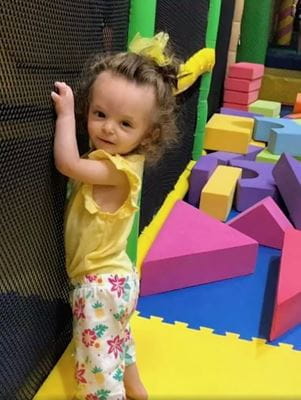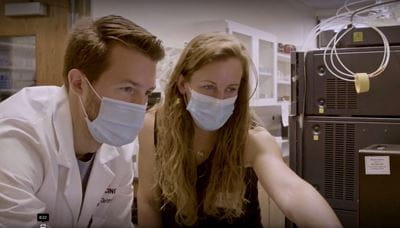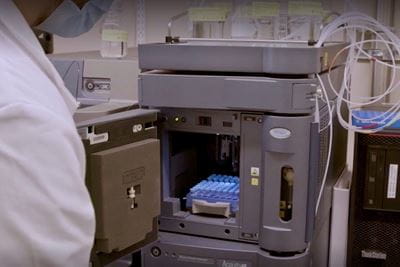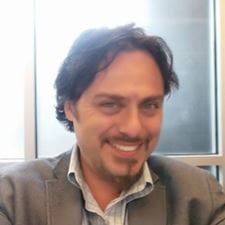Over 7,000 miles across the globe, Ali Albloushi, a 32-year-old-man from the United Arab Emirates (UAE), hadn’t been able to walk for years, suffering from an unexplained neuromuscular condition. During the last three decades, his family had traveled to see specialists throughout the UAE, in Germany and the United States, and still had no answers.
Until now.
The Edwards and Albloushi families now have renewed hope, thanks to the Undiagnosed Rare Disease Clinic (URDC) at Indiana University School of Medicine. Established in January 2020 through a grant from IU’s Precision Health Initiative, the URDC uses team science—often in collaboration with researchers across the globe—to sleuth out medical mysteries stemming from genetic code errors.
“Most of our patients have already been on a pretty long diagnostic odyssey,” said Erin Conboy, MD, a clinical and metabolic geneticist who was recruited to IU School of Medicine in 2019 to start up the URDC. “They’ve had the best, most well-known genetic test out there, but still, they have no answers. That’s when they come to our clinic.”
Solving medical ‘cold cases’
 Benjamin and Desiree Edwards had known from the start that something was wrong with their baby. Jordan had difficulty with feedings and wasn’t meeting benchmarks for height and weight gains. For two years, multiple doctors and tests could provide no answers. Her parents worried Jordan’s failure to thrive was somehow their fault.
Benjamin and Desiree Edwards had known from the start that something was wrong with their baby. Jordan had difficulty with feedings and wasn’t meeting benchmarks for height and weight gains. For two years, multiple doctors and tests could provide no answers. Her parents worried Jordan’s failure to thrive was somehow their fault.
In early 2020, the URDC team performed advanced genetic testing on each member of the Edwards family and eventually discovered Jordan had a rare disorder caused by an insulin-like growth factor (IGF) gene mutation. She became the clinic’s first solved case.
For the Albloushi family, hope for an answer had nearly been extinguished when they serendipitously stumbled upon the genetic detectives at the URDC. They had traveled to Indiana for a completely different reason—a kidney transplant for Ali’s father.
When IU Health’s liaison for international patients saw Ali’s mobility issues and learned about the family’s long odyssey to find an answer, he connected them to Laurie Gutmann, MD, chair of the Department of Neurology and co-director of the Neuroscience Institute at IU School of Medicine and IU Health. She enlisted the help of the experts at the URDC, who conducted advanced genetic testing.
Several weeks later, the Albloushi family received the news they had been waiting to hear for 30 years—the definitive cause of Ali’s condition, along with his sister, Alia, who has the same disorder. Back home in the UAE, the family had a virtual meeting with Conboy and Gutmann to go over the findings. Ali’s brother, Mohammed, helped communicate the news to his family in Arabic.
 “My mom was crying. Ali was very surprised—he was silent and emotional,” Mohammed said. “If you talked to us two years ago, we’d almost lost hope. Now it’s different. The gene is identified and soon—hopefully—they will find a cure for this.”
“My mom was crying. Ali was very surprised—he was silent and emotional,” Mohammed said. “If you talked to us two years ago, we’d almost lost hope. Now it’s different. The gene is identified and soon—hopefully—they will find a cure for this.”
When dealing with rare genetic diseases, a diagnosis may not immediately result in an effective treatment, but it helps guide the course of therapy, provides a sense of closure, and often helps families determine the risk of recurrence for subsequent pregnancies. The discovery process can also help these families connect with others around the globe who have similar rare syndromes.
“Any kind of answer, even the beginning of an answer, helps to bring some solace to a difficult situation,” Conboy said. “Dealing with the unknown is a lot harder than at least knowing what you are facing and beginning to take steps forward to understand it. Having an answer improves families’ mental and emotional health.”
Matchmaking for sleuthing scientists
The human body has about 25,000 genes. Scientists only know what 5,000 of them do. This is why the best genetic test available—whole exome sequencing—results in diagnosis of a known genetic condition only in about a third of “mystery” cases, Conboy said.
To solve a case involving one of the 20,000 unknown genes, URDC researchers seek out similar cases—wherever in the world they may be. The Gene Matcher and Match Maker Exchange global networks have allowed URDC researchers to connect with scientists throughout the United States and in Italy, China, England and the Netherlands.
 “It’s a sort of social media for geneticists that connects different institutions and researchers around the world who are interested in the same disease and same mysterious gene candidate,” explained Francesco Vetrini, PhD, the URDC’s leader of clinical genomics.
“It’s a sort of social media for geneticists that connects different institutions and researchers around the world who are interested in the same disease and same mysterious gene candidate,” explained Francesco Vetrini, PhD, the URDC’s leader of clinical genomics.
Collaborating with other institutions, the URDC team has made important discoveries about a gene known as BICRA, which is the source of a newly identified neurodevelopmental disorder causing intellectual disability and facial dysmorphia.
Solving these kinds of medical mysteries takes a team effort.
Vetrini earned his PhD in medical genetics in Naples, Italy, and was a clinical genomics scientist at Baylor University before coming to IU School of Medicine in 2018 as an American Board of Medical Genetics and Genomics (ABMGG) fellow in the Department of Medical and Molecular Genetics. Due to his expertise in rare disease and new gene discovery, he was recruited to help Conboy start up the URDC.
 “We established this program from the ground up—from scratch,” Vetrini said. “We have definitively solved at least five cases, which is a great achievement. We would like to be able to solve more cases through complex analysis and research collaborations, keeping up with new technology for our clinic, and hiring more genomic scientists to help in this effort.”
“We established this program from the ground up—from scratch,” Vetrini said. “We have definitively solved at least five cases, which is a great achievement. We would like to be able to solve more cases through complex analysis and research collaborations, keeping up with new technology for our clinic, and hiring more genomic scientists to help in this effort.”
The URDC currently has promising leads on a fifth of its cases. Marked on a spreadsheet in blue, these “possibly solved” cases need funding for further experiments. All of the URDC’s sleuthing services are free to patients, so Conboy’s team is seeking out grants and donations to further their work.
“We’re just so close on so many cases,” Conboy said. “I stare at those blue cases and keep thinking about how we can solve them.”
Finding the ‘smoking gun’
“Solving a medical mystery involves analyzing different sets of evidence on the ‘crime scene,’” Vetrini said. “We are examining direct evidence, indirect evidence, supporting evidence—and then maybe there’s the smoking gun. It’s very exciting when you can solve it. I feel this eureka sensation when I can turn to a family and say, ‘We have the smoking gun—this is the causative gene mutation in your family.”
Getting to that exhilarating moment takes a dedicated, multidisciplinary team.
 Patients’ DNA samples are sent to the Indiana Biobank and then analyzed by biochemical geneticists and bioinformaticians at the Center for Medical Genomics. Genome data is also sent for re-analysis to Emedgene, a private genomic diagnostics and discovery company which uses artificial intelligence. All of the discovered genome and exome data then goes to the URDC’s Genome Board, consisting of IU biomedical geneticists, genetic counselors, disease and genomics experts, lab directors, analysts, rare disease postdocs and other interested researchers.
Patients’ DNA samples are sent to the Indiana Biobank and then analyzed by biochemical geneticists and bioinformaticians at the Center for Medical Genomics. Genome data is also sent for re-analysis to Emedgene, a private genomic diagnostics and discovery company which uses artificial intelligence. All of the discovered genome and exome data then goes to the URDC’s Genome Board, consisting of IU biomedical geneticists, genetic counselors, disease and genomics experts, lab directors, analysts, rare disease postdocs and other interested researchers.
“There are many people involved—this would not be possible without our exceptional team,” Conboy said. “I spent most of 2020 facilitating communication between teams that had not previously worked together and creating a process for that collaboration within IU Health and IU School of Medicine.”
 From a patient’s first visit to the URDC, Genetic Counselor Kayla Treat is there to help families navigate the process.
From a patient’s first visit to the URDC, Genetic Counselor Kayla Treat is there to help families navigate the process.
“Patients can get very overwhelmed by medical terms,” she said. “As a genetic counselor, I can break things down to make it easier to understand. We don’t know how long it will take to find an answer, but we are on their team, and we’re not going to give up.”
Lili Mantcheva, MPH, is a recent addition to the team, serving as project manager. Her role is to keep the patient’s family informed while ensuring the many collaborators are working harmoniously to solve the case.
Not only does a closed case bring relief to a weary family, it also contributes greatly to the medical community’s understanding of unknown genes and disorders.
 “Ultimately, we will share this information with the clinical genetics community at large and contribute to the overall knowledge about previously mysterious disorders,” Vetrini said.
“Ultimately, we will share this information with the clinical genetics community at large and contribute to the overall knowledge about previously mysterious disorders,” Vetrini said.
For the families still waiting for answers, Conboy wants them to know, “We’re not going to give up—we’re going to keep looking. If it takes new gene discovery to diagnose your child, then we’re going to try to do that.”
As for the Albloushi family, their 30-year cold case has finally been solved.
“We are grateful for technology, and we are really, really grateful to everyone at IU who spent their time working on this case,” Mohammed said. “We almost lost hope. We love to share our story because there are a lot of people still fighting to find an answer.”
